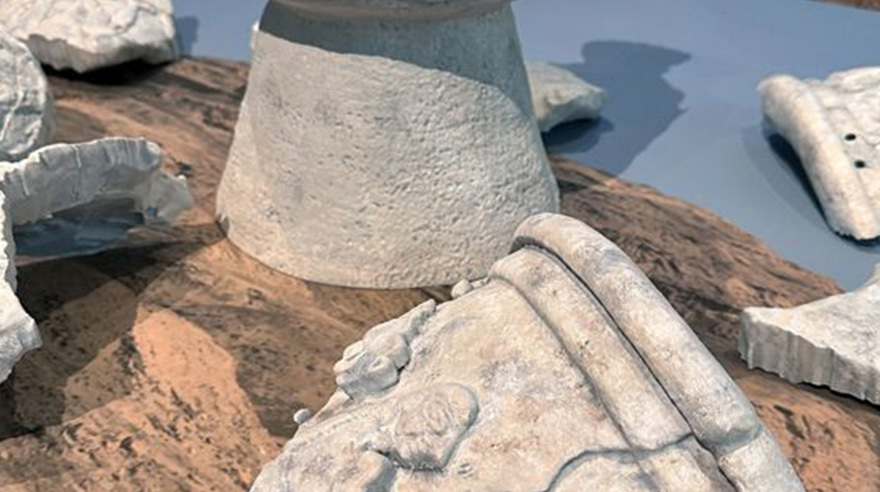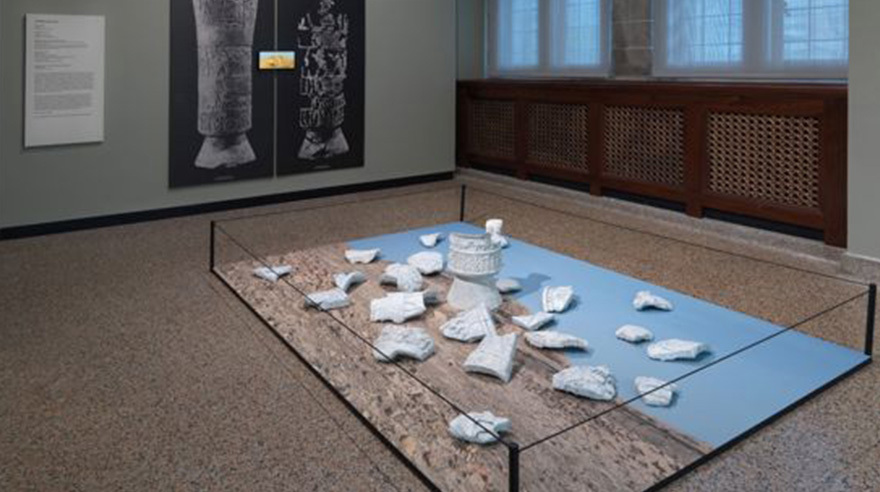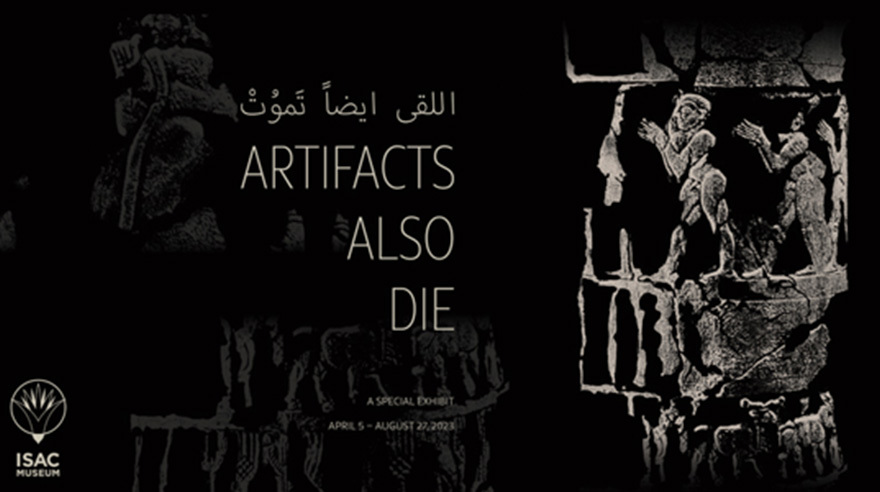At the University of Chicago’s Institute for the Study of Ancient Cultures (ISAC), a special exhibition has been running.
Artifacts Also Die is curated by Dr Kiersten Neumann, inspired by a research project led by Iraqi-British artist and academic Dr Hanaa Malallah entitled Ruins, Rubble, and Renewal: Co-existent Ruins—Exploring Iraq’s Mesopotamian Past through Contemporary Art.
A replica of the Warka Vase is central to this exhibition, in an installation that epitomizes the turbulent history of ancient Mesopotamian heritage sites and how, due to conditions in the Middle East, ancient artifacts at risk, as well as our current destructive relationship with the earth at large.
The Warka Vase is an ancient artifact that dates back to around 3200 BCE. It was discovered in Uruk (modern Warka), an ancient city in Mesopotamia (modern-day Iraq), and is considered one of the most significant examples of Sumerian art.
It was originally excavated in fragments in the early 20th century and was restored and displayed in the Iraq Museum in Baghdad. It was taken during the looting of the museum in 2003 that followed the US-led invasion of Iraq. The vase was then returned to the museum in fragments and once again restored and put on display to the public.
Made of alabaster, the original Warka Vase stands at 1 meter tall, and is intricately carved with detailed relief sculptures depicting various scenes from ancient Sumerian mythology and daily life, with a focus on agriculture and cyclical renewal.
“I continue to see seven levels of representation on the body of the Warka Vase, rather than five (water, vegetation, animal, human, and divine) as most scholars propose. In my view, the empty bands embody a meaning that adds to its rhetoric, which is up to us to compose.” - Dr Hanaa Mallalah.
The Warka Vase is the earliest example of narrative art from Mesopotamia and provides valuable insights into the cultural, religious, and economic practices of the Sumerian civilization, but with the Warka Vase currently housed in Baghdad, one of the key challenges for the ISAC Museum’s team is how to maintain the authenticity and integrity of the experience without displaying the original artifact.
In the late 19th and early 20th centuries, creating plaster-cast replicas of artifacts was standard practice, but the copies did not always fully reproduce the material qualities of the originals, impacting the overall richness of the visitor experience. The practice is far less common nowadays, as conservators advocate minimal handling of original artifacts to reduce the risk of damage and the practice itself can be fairly labor intensive.
To address these challenges, museums are employing alternative strategies to represent the original artifacts. Many turn to technologies such as virtual or augmented reality - but others, like the ISAC Museum, also employ the unique qualities of PolyJet 3D printing to provide beautiful, high-precision replicas that reestablishes the impact and emotional connection that visitors have with an exhibition and conveys the material qualities and nuances of the original artifacts.
“We were keen from the outset to use a 3D printed replica of the Warka Vase, so I reached out to colleagues at the Materials Research Science and Engineering Center (MRSEC) at the University of Chicago whom I had worked with on previous printed artifacts to see if they could help, and they connected us with Stratasys, recommending the PolyJet technology for our project.” - Dr Kiersten Neumann
Josh Tulisiak, Manager of Exhibition Design and Production, worked with the initial scan from Hanaa to create the individual fragmented files for the 3D prints. It was a painstaking process for Hanaa, as she worked with photographs to build up a complete 3D scan of the vase.
The result of her efforts is a captivating video showing the Warka Vase from all angles as it falls to pieces, with the monumental Mesopotamian ziggurat (stepped tower) of Uruk in the background. To accompany the video, the team decided to create the 3D print of the vase as fragments, rather than an intact replica. Highlighting the focus of the exhibition on Mesopotamian ruins and our present destruction of the planet and its cycle of renewal, these fragments also stand as a poignant reference to the Warka Vase’s perilous recent history.
To this end, the 3D-printing specialists at MRSEC worked with Stratasys to create the fragments of the vase from Josh’s CAD files using the J850™ Prime PolyJet 3D printer.
PolyJet is a powerful 3D printing technology that produces smooth, accurate parts, prototypes and tooling - and the J850 Prime PolyJet printer is well-suited for printing museum replicas due to its high level of detail, full-color printing capabilities, multi-material versatility, large build volume, and efficient support material removal.
It can accurately reproduce intricate details, vibrant colors, and various textures, closely resembling the original artifacts. Its intuitive software makes the J850 Prime famously easy to use, and with its ability to handle complex structures and accommodate larger dimensions, it enables museums to create comprehensive replicas.
Josh describes his reaction on printing the first vase fragment. “It was just amazing to see it. Until then we had only seen the digital version, and the prototypes we’d done on a different printer which weren’t of the quality we wanted. The resolution of the relief from the J850 was fabulous.”
Creating the 3D printed Warka Vase fragments has enabled the ISAC Museum to enhance the visitor experience. Displayed on top of a 8x6ft photographic print of the archaeological site of Warka, it provides a unique opportunity to engage with the Warka Vase in a more tangible and immersive manner, allowing visitors to appreciate the texture and intricate details of the vase’s depicted scenes.
“It’s a brilliant execution of the vase. A perfect replica. The 3D printed fragments in combination with the installation’s video enriches and materializes the concept.” - Dr Hanaa Mallalah
3D printing replicas of ancient artifacts allows museums like the ISAC to bring history to individuals who may not have the chance to see the original artifacts in person to still experience and learn from them. It provides a unique opportunity for visitors to engage with history and cultural heritage in a more tangible and immersive manner. Instead of viewing artifacts behind glass cases, visitors can interact with 3D-printed replicas, examining them up close to appreciate the texture and intricate details of the objects.
The 3D printing of replica artifacts enhances the visitor experience, creating opportunities for hands-on engagement, and fostering a deeper connection to cultural heritage. The 3D print of the Warka Vase transforms the ISAC Museum’s installation into an interactive and immersive journey, leaving visitors with a greater appreciation and understanding of early civilizations.
Experience the beauty and history of the Warka Vase in the video below "Artifacts Also Die,” created by Hanaa Malallah, 2023.


